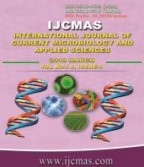


 National Academy of Agricultural Sciences (NAAS)
National Academy of Agricultural Sciences (NAAS)

|
PRINT ISSN : 2319-7692
Online ISSN : 2319-7706 Issues : 12 per year Publisher : Excellent Publishers Email : editorijcmas@gmail.com / submit@ijcmas.com Editor-in-chief: Dr.M.Prakash Index Copernicus ICV 2018: 95.39 NAAS RATING 2020: 5.38 |
The present work was conducted on oviduct of 42 Punjab white quails from 8 weeks to 32 weeks of age to study histological, micrometrical and histochemical details on the cranial and caudal parts of infundibulum. The samples were collected from cranial and caudal parts of infundibulum, processed for paraffin sectioning and were stained with various stains to observe detailed histoachitecture of infundibulum at various age groups. The results revealed that there was numerous of mucosal folds in the cranial part of infundibulum which decreased in the caudal part of infundibulum. The lining epithelium of infundibulum was simple columnar ciliated with ciliated and non-ciliated cells. The proprial glands were mainly present in the caudal part of infundibulum. The amount of fibrous components was less in the infundibulum. The micrometrical studies showed that the length and number of mucosal folds was maximum in the cranial part of infundibulum which decreased in the caudal part. Histochemical observations depicted moderate PAS, bromphenol blue and Sudan Black B reaction was seen in the epithelium whereas moderate to strong PAS/AB activity was observed in infundibular glands and lamina epithelialis in caudal part. The later may be due to the secretory activity in the epithelium and glands. The present study concludes that the histomorphometrical and histochemical data on the infundibulum of Punjab white quails can be correlated with the reproductive status at different age groups.
 |
 |
 |
 |
 |